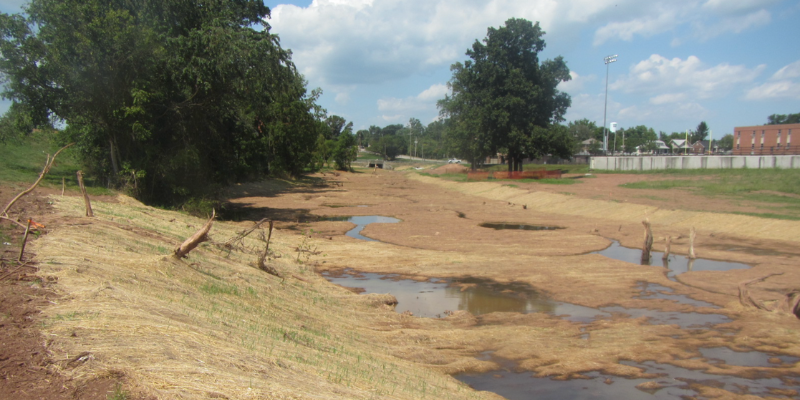Controlling runoff and soil erosion during excavation requires careful planning, experience, and the right tools. Without proper control, rainfall and runoff can wash away valuable topsoil, cause instability, and send sediment-laden water into nearby streams or storm drains. It can also wash away any goodwill a construction company has earned in the community. At Flyway Excavating, we take a proactive, systems-based approach to protect the land and surrounding waterways during every phase of construction.
Maintaining Soil Stability During & After Construction
Our first priority when we start any project is installing the necessary measures to ensure soil stability and prevent all sediment-laden water from entering the waterways. This is followed by the clearing of trees and shrubs to gain access to the site, and then stabilizing the soil affected by their removal. Further stages continue to address these needs with the following steps:
-
- Grading & Compaction – In this stage, we carefully shape the land to control how water moves across it. Strategic grading and soil compaction strengthen the ground, reduce settlement, and ensure runoff flows in controlled directions rather than eroding exposed surfaces.
- Benching & Terracing – Benching and terracing help slow down water flow on steep slopes. By cutting steps or plateaus into the slope, these methods give water more time to soak into the soil, reducing the potential for washouts and slope failures.
- Temporary Seeding & Mulching – During active site work, exposed soil is especially vulnerable. We stabilize these areas with temporary grass seeding and straw or mulch blankets, which shield the surface from raindrop impact and wind until permanent vegetation can be established.
- Erosion-Control Mats & Geotextiles – On challenging slopes or drainage channels, we use biodegradable mats or geotextile fabrics to hold soil in place. These materials allow water to pass through while keeping sediment contained, ensuring stability until root systems take hold.
- Topsoil Restoration & Permanent Vegetation – Topsoil is replaced and native vegetation is planted to provide long-term stability when work has been completed. Deep root systems naturally anchor the soil and help filter stormwater, maintaining erosion control for years to come.
- Riprap, Gabions & Retaining Walls – For high-energy areas like drainage outfalls or steep embankments, structural solutions such as riprap, gabions, and retaining walls absorb water’s force and protect the surrounding soil from erosion.
- Drainage Systems – Engineered swales, culverts, and French drains move water safely away from disturbed ground. These systems prevent pooling, protect structures, and maintain the integrity of finished landscapes.
Keeping Muddy Water Out of Streams
Preventing sediment from entering waterways is critical to maintaining local ecosystem health. These are the sediment-control measures we regularly use to ensure compliance and environmental protection.
-
- Silt Fences & Fiber Rolls – These simple but effective barriers are installed along the edges of disturbed areas to slow runoff and trap sediment.
- Erosion-Control Berms & Dikes – Small ridges or berms of gravel or soil redirect stormwater away from wetlands and stream banks.
- Sediment Traps & Basins – Temporary basins capture runoff, allowing suspended particles to settle before water is released.
- Check Dams – These small rock or log barriers slow water in drainage ditches or channels, reducing its erosive power.
- Stabilized Construction Entrances – Gravel pads at site exits prevent mud from being tracked onto public roads and into storm systems.
- Stream Buffers – Strips of vegetated land along waterways act as natural filters, catching sediment and absorbing pollutants.
- Diversion Ditches & Temporary Culverts – As needed, clean water is safely rerouted around construction zones to keep natural flows undisturbed.
A Commitment to Responsible Site Management
Flyway was founded on the basic tenet that erosion control isn’t just a compliance issue — it’s a responsibility. By combining practical engineering with environmental stewardship, we help safeguard both construction sites and the ecosystems that surround them. Every project we take on reflects our commitment to building strong foundations with our construction partners and the greater community.
To prevent soil loss and waterway pollution on your project, contact our team of experts. We’re always ready to help.
